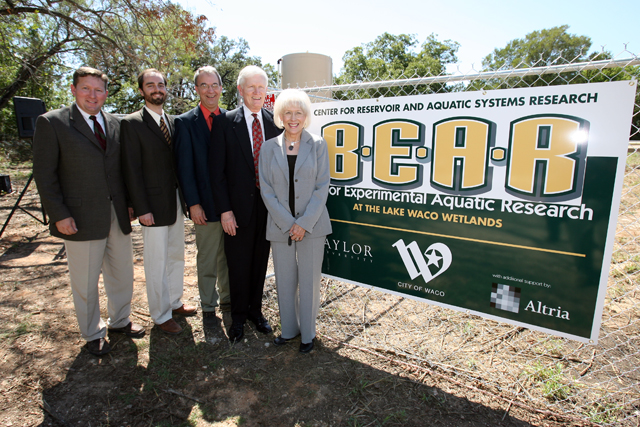Baylor and Waco Open New Research Facility

With the new water research center glistening behind them, Baylor University President John M. Lilley and Waco Mayor Virginia DuPuy officially opened Baylor Experimental Aquatic Research (BEAR) facility on Sept. 20 at the Lake Waco Wetlands.
The new aquatic research center will provide researchers a place to test complex water quality experiments that could ultimately benefit the City of Waco and address the taste and odor problems of Waco's drinking water.
"One important conviction underlying Baylor 2012, our 10-year vision, is that we should encourage the understanding and care of the natural world as a matter of Christian stewardship," Lilley said. "We hope that the work conducted here will allow our researchers to contribute to international efforts to provide clean water for everyone."
"Reservoirs such as Lake Waco provide virtually all of the available surface water in the southwestern United States, thus the protection and wise use of water resources is essential for continued natural resource and economic health in central Texas." DuPuy said. "Information from BEAR studies will allow City managers of Lake Waco and the Waco Metropolitan Area Regional Sewerage System (WMARSS) to make informed water quality management decisions based on sound science."
The only one of its kind at an academic institution in the United States, the BEAR facility is outfitted with 12 miniature "real life" streams, which can be manipulated to look and act like streams found across central Texas and in other regions. Drawing treated water from the nearby wetlands, the model streams have "riffle, run and pool" sections that exceed 60 feet in length.
Dr. Ryan King, lead principal researcher at BEAR and an assistant professor of biology at Baylor, and Dr. Bryan Brooks, an assistant professor of environmental studies at Baylor, will be able to put different levels of nutrients in each stream and then study how each nutrient level might affect water quality and wildlife. State and local water managers will be able to use the data collected at the facility as the scientific basis for improved water quality management strategies.
"This experimental facility will allow us to ask and answer some questions that can't be fully understood in the field or in the lab," Brooks said. "When we couple what the research tells us here with observations in the field, we will be able to link cause and effect."
Funded by a grant from the Altria Foundation with significant matching support from Baylor and Waco, the BEAR facility also will allow researchers to study possible contaminants in the drinking water supply. Researchers will be able to study how long a certain contaminant, like a pesticide or another chemical, stays in the stream, how it breaks down and the overall impact on wildlife and water quality. To date, there is very limited research into the environmental fate and effects of many emerging aquatic contaminants.
"We will be able to identify critical concentrations of a certain contaminant," King said. "We will be able know that if we have 'X' amount of a certain contaminant, what the impact would be on the stream, wildlife and how we could prevent it from getting into the water supply in the first place."
Part of Baylor's Center for Reservoir and Aquatic Systems Research (CRASR), the new research center is a joint project with the City of Waco. The facility sits on city-managed land and was constructed by Baylor students, faculty and city workers, using city-donated and Baylor-purchased supplies. Waco city water managers also are planning to use the research as the scientific basis for local water management strategies.
"The BEAR facility will allow us to look at different alternatives on a pilot scale," said Tom Conry, water quality administrator for the City of Waco and a Baylor graduate. "We can look at biomanipulating certain factors that could ultimately lead to the better protection of our drinking water."
In addition to the model streams, the research facility is outfitted with 24 model wetlands, which were developed by Dr. Robert Doyle, director of CRASR and chair of the biology department at Baylor. The wetlands will allow Doyle and other researchers to conduct similar nutrient tests.